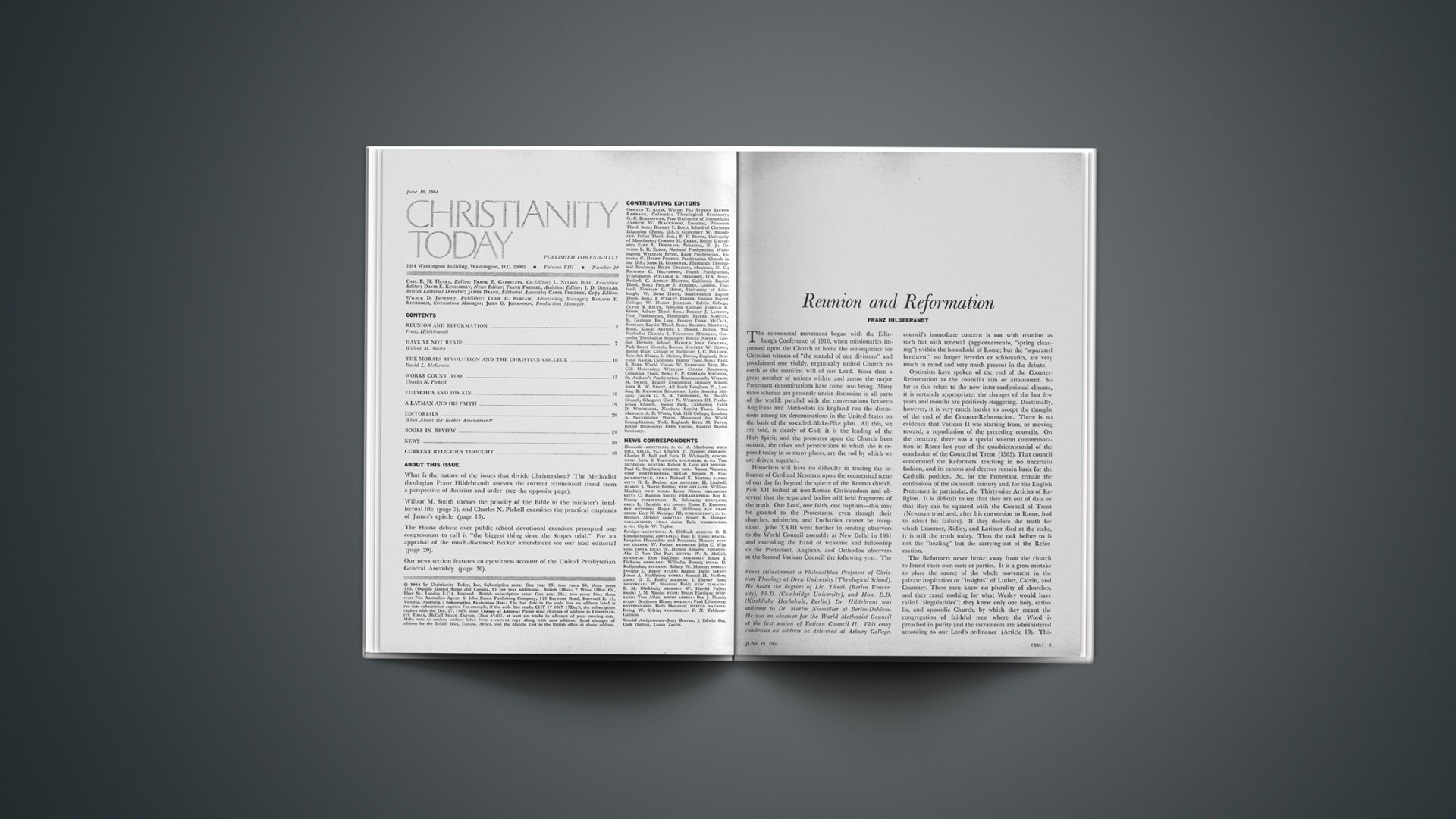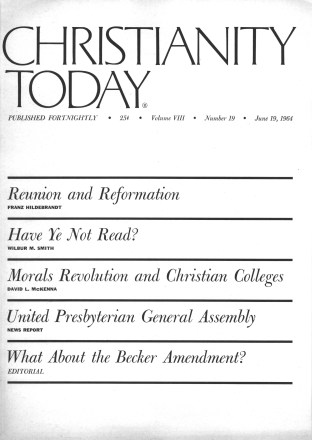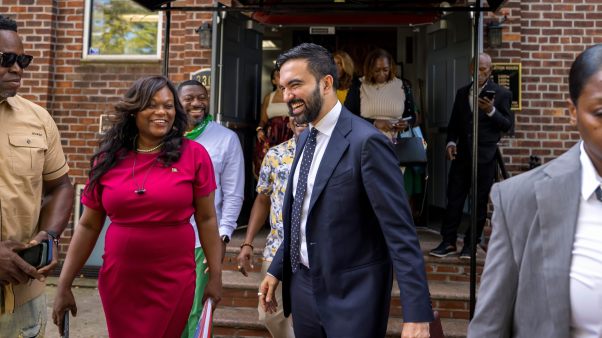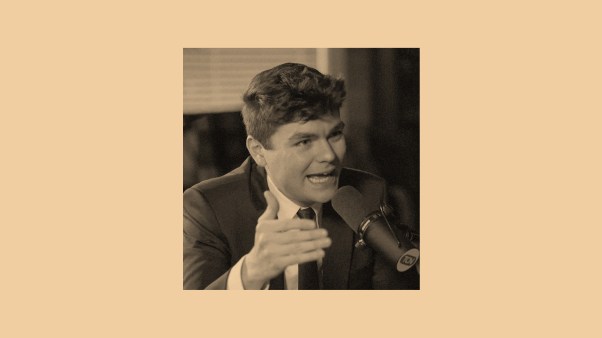The ecumenical movement began with the Edinburgh Conference of 1910, when missionaries impressed upon the Church at home the consequence for Christian witness of “the scandal of our divisions” and proclaimed one visibly, organically united Church on earth as the manifest will of our Lord. Since then a great number of unions within and across the major Protestant denominations have come into being. Many more schemes are presently under discussion in all parts of the world; parallel with the conversations between Anglicans and Methodists in England run the discussions among six denominations in the United States on the basis of the so-called Blake-Pike plan. All this, we are told, is clearly of God; it is the leading of the Holy Spirit; and the pressures upon the Church from outside, the crises and persecutions to which she is exposed today in so many places, are the rod by which we are driven together.
Historians will have no difficulty in tracing the influence of Cardinal Newman upon the ecumenical scene of our day far beyond the sphere of the Roman church. Pius XII looked at non-Roman Christendom and observed that the separated bodies still held fragments of the truth. One Lord, one faith, one baptism—this may be granted to the Protestants, even though their churches, ministries, and Eucharists cannot be recognized. John XXIII went further in sending observers to the World Council assembly at New Delhi in 1961 and extending the hand of welcome and fellowship to the Protestant, Anglican, and Orthodox observers at the Second Vatican Council the following year. The council’s immediate concern is not with reunion as such but with renewal (aggiornamento, “spring cleaning”) within the household of Rome; but the “separated brethren,” no longer heretics or schismatics, are very much in mind and very much present in the debate.
Optimists have spoken of the end of the Counter-Reformation as the council’s aim or attainment. So far as this refers to the new inter-confessional climate, it is certainly appropriate; the changes of the last few years and months are positively staggering. Doctrinally, however, it is very much harder to accept the thought of the end of the Counter-Reformation. There is no evidence that Vatican II was starting from, or moving toward, a repudiation of the preceding councils. On the contrary, there was a special solemn commemoration in Rome last year of the quadricentennial of the conclusion of the Council of Trent (1563). That council condemned the Reformers’ teaching in no uncertain fashion, and its canons and decrees remain basic for the Catholic position. So, for the Protestant, remain the confessions of the sixteenth century and, for the English Protestant in particular, the Thirty-nine Articles of Religion. It is difficult to see that they are out of date or that they can be squared with the Council of Trent (Newman tried and, after his conversion to Rome, had to admit his failure). If they declare the truth for which Cranmer, Ridley, and Latimer died at the stake, it is still the truth today. Thus the task before us is not the “healing” but the carrying-out of the Reformation.
The Reformers never broke away from the church to found their own sects or parties. It is a gross mistake to place the source of the whole movement in the private inspiration or “insights” of Luther, Calvin, and Cranmer. These men knew no plurality of churches, and they cared nothing for what Wesley would have called “singularities”; they knew only one holy, catholic, and apostolic Church, by which they meant the congregation of faithful men where the Word is preached in purity and the sacraments are administered according to our Lord’s ordinance (Article 19). This to them was not a matter of new viewpoints versus old but a grim battle of truth against error; Luther, at the end of his life, insisted that “we are the true old Church” of prophets and apostles, known by the seven authentic marks of Word, Baptism, Holy Communion, Ministry, Absolution, Prayer, and Cross (meaning the suffering Church). In the midst of the intemperate polemic of his anti-papal writings, he remained conscious with fear and trembling of the peril of his lonely stand over against a majority not merely of contemporaries but of centuries. Yet the choice is not his; it is forced upon him by the Word of God which is the author of the Reformation. The Word, not Luther, condemns the abuses of Rome, and indeed condemns any deviation and distortion to which Protestantism falls guilty.
Doctrine, therefore, is primary, while order is always secondary to faith; this is a complete reversal of the current ecumenical trend. Our main burden of separation today arises at the point of recognition of orders and unification of ministries. The Bible, the historic creeds, the observance of the two sacraments we seem to take for granted, and our real troubles always begin with the fourth point—the Historic Episcopate—of the Lambeth Quadrilateral (1888). For the Reformers, as for the Wesleys, it was unity in the Gospel that mattered above everything else; and with such unity varying forms of ministry and church government—for instance, episcopal and non-episcopal—were fully compatible. John 8:31 does not read, “If you are among the right disciples, you will continue in my word,” but, “If you continue in my word, you are truly my disciples.”
Three Great Tenets
What is the doctrine of the Reformation? It is summed up in three phrases: sola scriptura, solo Christo, sola gratia.
Scripture is the one source of revelation and the sole norm of the Church’s faith and life. Contemporary Catholics may go as far as to accept the formula, Sola scriptura in ore ecclesiae (Scripture alone in the mouth of the church), and Protestants will readily admit that Scripture itself historically viewed forms part of tradition, “apostolic” as distinct from “ecclesiastical” tradition; but such formal statements do not affect the fundamental issue. In the eyes of the Reformers, theological argument must be based exegetically, the case supported by chapter and verse, and the final appeal made to the Word of God. And without the daily ration of that Word the flock of Christ cannot be fed. The pulpit is missing in St. Peter’s church as indeed the Gospel is missing in countless Protestant churches. At this point judgment must begin upon the house of God. The Protestant will always be, with John Wesley, a man of one book; listening, to be sure to all voices of tradition, ancient and modern, as witnesses and commentators, but subjecting them as well as himself to the ultimate authority of Scripture, and keeping a clear distinction between what is “prescribed” in, and what is merely “agreeable” to, Holy Writ. Bishops, for instance, fall under the second category and can therefore never be made binding upon the Church, not even for the sake of union.
Solo Christo: “For there is one God, and one mediator between God and men, the man Christ Jesus” (1 Tim. 2:5). This, too, remains a live issue between Reformation and Counter-Reformation. Not only do “the crownrights of the Redeemer” preclude any mediatorial role attributed to Mary and the saints; they also rule out, more importantly, any direct identification between Christ and the Church. The Church is neither the “extension of the incarnation” nor Christ in sacramental form. He is her Master and Lord; he is the head of his Body. The gulf that divides us here from our Eastern as well as from our Roman brethren became apparent when at Evanston in 1954 the Eastern Orthodox delegates felt unable to join in the Church’s confession of sin as drafted by the World Council; the mystical Body of Christ, they felt, could never be so convicted. In reply, we would have to read the seven letters of Revelation 2 and 3 where Christ stands vis-à-vis the “angels” (elders) and passes judgment upon his delinquent church: “I have somewhat against thee … except thou repent … to him that overcometh will I give …” (Rev. 2:4 ff.).
Finally, sola gratia: “By grace are ye saved … not of works” (Eph. 2:8 f.). For the Reformers this is the heart of the Gospel and the end of the Mass. Where Christ through the hands of priest and faithful at the height of the Roman service offers himself to the Father as the bloodless sacrifice for the living and the dead, there the Protestant must rise in protest. For “where remission of [sins] is, there is no more offering for sin” (Heb. 10:18). And if this meant for several of us who were observers in Rome that we could not in conscience attend the daily Mass with which each council session began, it means that the minister of word and sacrament can never become, or ever agree to be called, a sacrificing priest. Our deepest division lies here. Pope, Virgin, and saints could not ultimately stand between us, if Protestants could go to Mass and Catholics to our Communion. We are brethren in Christ, we can talk, work, pray together, and in joint prayer we can even use quite a few words from the Missal; but when we go to the Lord’s Table in our separate churches, it is two diametrically opposite interpretations of his last will that hold us apart.
At this point Reunion clashes with Reformation. The question we have to face can be stated in an analogy to the passage in which Jesus, when asked about the authority of his ministry, retorted: “The baptism of John, whence was it? from heaven, or of men?” (Matt. 21:25a). “The Reformation of the sixteenth century, was it sincere, profound, religious, a genuine quest for truth on the part of admirable, though one-sided, perhaps tragically misguided men (as Catholic scholars today are ready to grant), or was it the work of the Spirit of God?” It makes all the difference in the world whether the Reformation can be written off as a past event—at best a tenable viewpoint, a partial and partisan aspect of Christianity—or whether, as the authentic voice of God’s own reforming Word, it is still norma normans for the Church.
The Constant Criterion
For us this is as crucial as is the episcopal succession for our Catholic brethren; it is the norm by which we are bound and from which we are not free to depart. “It is not necessary that traditions and ceremonies be in all places one, or utterly alike; for at all times they have been divers” (Article 34 of the Thirty-nine Articles); but it is necessary to be united in the understanding and preaching of the Word and the scriptural administration of the sacraments. Indeed, the true apostolic succession is not guaranteed by lineal descent through what Benjamin Gregory a hundred years ago called “digital contact”; it is found only where men continue “steadfastly in the apostles’ doctrine and fellowship, and in breaking of bread, and in prayers” (Acts 2:42). The constant test for every ministry is faithfulness to the Gospel; where this is lacking, no legacy or ancestry, however “historic,” can mend the defect.
Therefore, in the words of a sixteenth-century Catholic bishop, all attempts at reunion are fruitless without a preceding reformation. Paradoxically it could well be that Protestants in these days have again to learn this from Rome! Where does it leave the several denominations gathered in the World Council of Churches? Karl Barth suggested long ago to the battling Lutherans and Calvinists in Germany that they should learn to understand their differences in terms of schools rather than of churches, and this, it seems to me, is a profitable category that allows for wider application. Lutherans and Reformed, Wesleyans and Anglicans can legitimately live side by side, like sister seminaries within one tradition, or Oxford and Cambridge colleges within one university, or again Franciscan and Dominican orders under the roof of the one Roman Catholic Church. Such diversities of schools do not justify mutual excommunication; “… fellowship with all, we hold who hold it with our Head,” said Charles Wesley. And he said it in a hymn on the Lord’s Supper. Schools have indeed a duty and right to take their own tradition seriously as well as to encourage interchange of students and teachers. We have a great deal to learn and gain from tutors under whom we were not brought up—so long as they are tutors “unto Christ.” No one knew this better than John Wesley, who gave to the Methodist people in England Bengel’s Notes on the New Testament and to the Methodists in America the shortened Articles of Religion for their standard textbooks. Officially both Anglicans and Methodists still stand by the Articles; and if both could be brought to reaffirm them in earnest, the story and the future of our conversations would be very different indeed.
What world Methodism has to bring as its theological contribution to the treasury of the universal Church is, in fact, already indicated by this reference to its doctrinal standards. They are, apart from the Articles, a set of expository books: Wesley’s Sermons, Wesley’s (Bengel’s) Notes, and (unofficial but at least as important) Wesley’s Hymns. As a son of the Protestant Reformation, Wesley, the “Bible bigot,” can by definition be nothing else than commentator and annotator of the sacred text. He sees things in the New Testament that Luther and Calvin did not see with equal clarity (and vice versa). He sees that the cry, “Who shall deliver me from the body of this death?” is followed by the assurance that “there is therefore now no condemnation to them which are in Christ Jesus”; that the doxology, “Of him and through him, and to him, are all things” is followed by the demand “that ye present your bodies a living sacrifice, holy, acceptable unto God”; that the ascension of Christ into heaven is followed by the promise of his abiding presence in our midst, his hand raised in blessing rather than in parting, his power “confirming the word with signs following.” In short, Heilsgeschichte is not enough; the third article in the creed must follow the second and must be spelled out in order to make us see “what hath God wrought” in our own day. There is in Wesley and in Asbury a great deal of undiscovered material not just for evangelism in the narrower technical sense of that term, but for the evangelization of theology itself. And in mid-twentieth century, when theological jargon has for the ordinary Christian become as hideous as it is unintelligible, we can do with a dose of Wesley’s beautifully lucid English “for plain unlettered men”! Our gloomier prophets talk about the end of the Protestant era; to the open-minded student of Wesley, it would seem that the Protestant era has hardly begun.
Some Ecumenical Lessons
The ecumenical lessons to be drawn from all this are obvious. First, the scandal of our divisions is not, as we are persistently told to believe, the mere existence of separate denominations as such. That we come from different schools, refer to different headquarters, adhere to different forms of worship, ministry, and government, is not in itself hurting the Body of Christ or grieving the Holy Spirit. The real scandal, right across all denominations and within each one of them, is the absence of the Gospel from our pulpits, the uncertain sound of the trumpet at the moment of battle, the chaos of conflicting voices that makes it impossible for men to hear what the Spirit says unto the churches. Accordingly, prayer for unity is not petition for merger schemes, but “that all who profess and call themselves Christians may agree in the truth of Thy holy Word and live in unity and godly love.”
As with the Gospel, so with the sacrament: the scandal of our divisions is not in the variety of communion rules and rituals but in the absence of brethren, through exclusion or abstention, from the table of the one Lord. (I am speaking, of course, not of the insuperable barrier that exists between the sacrifice of the Mass and the service of the Lord’s Supper, but of canonical rubrics preventing communion between those who have no other grounds for keeping apart.) Where loyalty to one’s own church or school is put above obedience to our common Lord, where in the name of discipline or organic unity his open invitation is refused, where in the growing practice of ecumenical conferences attendance at one another’s Eucharist takes the place of full communion, there Christ is divided amongst us and his name blasphemed.
Wesley’s journal records an episode from his early days in Georgia that has a direct bearing upon our present situation: “I was impressed by a friendly letter from an excellent man, whom I had not heard from for several years. What Christian piety and simplicity breathed in these lines! And yet this very man, when I was at Savannah, did I refuse to admit to the Lord’s Table, because he was not baptized, that is, not baptized by a minister that was episcopally ordained. Can anyone carry High Church zeal higher than this? And how well have I since been beaten with my own staff!”
The Incomparable Treasure Of Scripture
Here is the spring where waters flow,
to quench our heat of sin:
Here is the tree where truth doth grow,
to lead our lives therein:
Here is the judge that stints the strife,
when men’s devices fail:
Here is the bread that feeds the life,
that death cannot assail.
The tidings of salvation dear,
come to our ears from hence:
The fortress of our faith is here,
and shield of our defense.
Then be not like the hog that hath
a pearl at his desire,
And takes more pleasure in the trough
and wallowing in the mire.
Read not this book in any case,
but with a single eye:
Read not but first desire God’s grace,
to understand thereby.
Pray still in faith with this respect,
to fructify therein,
That knowledge may bring this effect,
to mortify thy sin.
Then happy thou in all thy life,
what so to thee befalls,
Yea, double happy shalt thou be,
when God by death thee calls.
(From the flyleaf of a copy of the Geneva Bible printed in London by the Deputies of Christopher Barker, 1599.)
The New Testament knows only one fence around the holy table: “Grace be with all them that love our Lord Jesus Christ in sincerity” (Eph. 6:24). The water of life is offered without any further conditions to him who listens, to him who is athirst, and to “whosoever will—freely” (Rev. 22:17). In emergency situations we recognize this. When in Holy Week of 1945 in a cell at Dachau (so small that there was barely room for eight people to stand or kneel) only one pastor, Martin Niemoeller, was available and only one language, German, was understood by the different nationalities and denominations, he administered the sacrament to them all. Who would dare to call it “invalid” or “irregular”? The way to unity, said William Temple, does not lead through the committee room. It leads through the use of the means of grace that Christ himself has appointed: the supper that he gave to his disciples that they might abide in him, and the Word by which (John 17) they are marked as his own, united in his love, called out from the world and sent forth into the world to witness. Denominations and organic unity are hardly on the horizon of that chapter; the plea of the great High Priest is that his own may be kept in the truth and love of his Word and that through them the world may believe.
St. Paul laid down the final criterion: that “every way, whether in pretense, or in truth, Christ is preached; and I therein do rejoice, yea, and will rejoice” (Phil. 1:18). The fullness of the Gospel in the New Testament sense is not a matter of quantity, a case of preserving or acquiring more or less of alleged historic substance of faith and order; it is rather the Gospel wherever it is in force “in power, and in the Holy Ghost, and in much assurance” (1 Thess. 1:5). When will we learn to look for that instead of examining our ministerial credentials and suspecting our party labels? When will we be happy to rejoice wherever Christ is preached, be it by Billy Graham or by Reinhold Niebuhr, in CHRISTIANITY TODAY or in the Christian Century or by the Vatican Council? A realignment of evangelical forces, a proper dialogue not only with our Catholic brethren but also inside our own Protestant camp, is long overdue.
It is possible to speak the truth in love without betraying the Reformation cause. The day of All Saints in the church calendar follows the day of Luther’s Ninety-five Theses. In all the churches we are called today to repent and do the first works: first not only in time (the recovery of our heritage) but also in importance (the priority of the Gospel). For the Reformation is by no means finished. Ecclesia semper reformanda—The Church is forever to be reformed.
Franz Hildebrandt is Philadelphia Professor of Christian Theology at Drew University (Theological School). He holds the degrees of Lic. Theol. (Berlin University), Ph.D. (Cambridge University), and Hon. D.D. (Kirchliche Hochshule, Berlin). Dr. Hildebrant was assistant to Dr. Martin Niemöller at Berlin-Dahlem. He was an observer for the World Methodist Council at the first session of Vatican Council II. This essay condenses an address he delivered at Asbury College.










